|
Toa Payoh
Vets Clinical Research
Making veterinary surgery alive
to a veterinary student studying in Australia
using real case studies and pictures |
Hamster Tumour Surgery and After-Surgery Care
Advices
Dr
Sing Kong Yuen, BVMS (Glasgow), MRCVS
First written: 09 March, 2009
Date:
09 August, 2010 |
 toapayohvets.com toapayohvets.com
Be Kind To Pets
Veterinary Education
Project 2010-0129 |
|
The following advice is applicable to the nursing of surgical wounds for
all hamsters operated by Toa Payoh Vets. |
E-MAIL TO DR SING
On Sat, 3/7/09,
...@hotmail.com> wrote:Subject: Hamster
operated by Dr Sing
To:
judy@toapayohvets.com
Date: Saturday, March 7, 2009, 9:18 AM
Hi there,
I sent my hamster in yesterday to have his tumor removed. So
far he seems to cope well with
his huge wound. Eating well, sleeping a lot, exercised on his
beloved wheel before every sleep...Stitches still intact. And
he can now walk straight without the extra load!!!
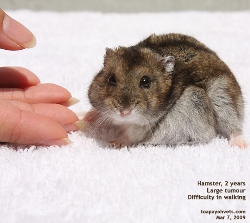
Would like to know how long does it takes for the wound to
close up?
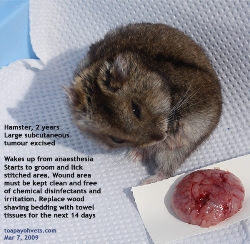
What should I do when the itch starts? I read online,
someone suggested applying edible Olive oil? Does it really
helps? As of now I've cleaned his wound 2 times already
with plain tap water. Can I use alcohol for disinfect purpose?
Will it be too painful for him? Someone online suggested
saline solution (Those used for contact lens), can I
really use that? And every time I cleaned his wound, I'm not
able to dry him, he won't let me touch his wounded area too
much. He will then licked himself very hard. Will licking cause
infection?
Thanks for reading this mail. I look forward to getting some
answers back:)
Thank You Toa Payoh Vet!!!
Best Regards,
Name of lady owner |
E-MAIL
REPLY FROM DR SING
AFTER SURGERY CARE FOR HAMSTERS
1. Over the years of practice, I note that many
hamsters and cats dislike any smell of chemicals on
their body after surgery. The first they do after
surgery is to lick their wounds and clean
themselves although they are groggy from
anaesthesia. So I always remove all the
blood stains from their body as much as
possible.
2. Hamsters will vigorously lick any chemicals in
antiseptics put on their skin by the veterinarian
and owners from their body vigorously. Sometimes
they get poisoned or diarrhoea. But human beings
including vets love using antiseptics and any
cleaning solution to "disinfect" the surgical
wound. It is generally believed that bacteria will
be "killed" by the use of antiseptics. But hamster
and feline behaviour is such that they don't want
such chemicals on their body and will lick them
away.
2. In your hamster wound nursing
post-surgery, I will recommend cleaning his wound
with a piece of facial cotton wetted with clean
boiled water 3X a day. Gently
remove his
blood clot or stains for the next 7 days.
If there is no blood after 3 days, don't disturb
the stitches by cleaning with antiseptics and
"online" advised solutions.
3. Also, keep the hamster on plain paper towel
tissue papers for the next 14 days till the wounds
heal. It is not possible to put an
Elizabeth
collar to prevent wound stitch biting. Or
to give
pain
killers as
dogs and
cats are given after surgery.
Therefore the owner takes a lot of responsibility
in ensuring that the wound is not infected and
that the hamster takes his medicine (antibiotics)
for the next 7 days.
4. Thank you for your feedback. I must say that
your hamster tumour is the biggest I have had
removed of all hamsters. Therefore, take good care
of the wound and check the hamster many times a
day. Clean non-infected wounds heal very well and
ensure that they are not licked excessively. The
absorbable sutures on his body should
dissolve in 14 days.
Best wishes.
Dr Sing
toapayohvets.com |
|
|
TREATMENT OF THIS CASE
Anaesthesia:
Zoletil 50 or 100 IM in less than 0.01 ml and isoflurane gas 5% for <10
seconds/instance. Topping up of gas in an anaesthetic
chamber/mask a few times in this case was necessary in this
case as Zoletil was inadequate. The hamster was
overweight for the dose to be effective, Sometimes Zoletil
50 IM alone will do. Zoletil 50 is given as a small drop
IM and as little as possible. When Zoletil is
insufficient, isoflurane gas top up will be necessary. In
Syrian Hamsters, Zoletil may be given IM in 3 drops to top
up. Isoflurane gas for a few seconds may be necessary.
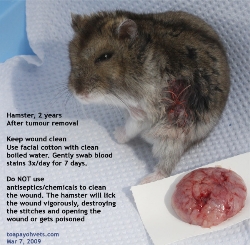 It is extremely difficult to know exactly when the hamster
is under surgical anaesthesia. There is a very small
margin for error. Observe the eyes and movement of
the hamster and give minimal dose of gas. It is easy to go
overdose if the vet or the assistant is not observant. It is extremely difficult to know exactly when the hamster
is under surgical anaesthesia. There is a very small
margin for error. Observe the eyes and movement of
the hamster and give minimal dose of gas. It is easy to go
overdose if the vet or the assistant is not observant.
Despite all attention, this hamster looked like he was
going to die when he became immobile for several seconds
after sniffing the isoflurane gas for the 3rd time. Just
sufficient dosage of anaesthesia is necessary to be able
to stitch up such a large wound. This is where the danger
of topping up with isoflurane gas a few times becomes
risky. However, there is a greater risk of the hamster
dying of shock due to intense pain and fright if
anaesthesia is insufficient and the hamster is struggling
vigorously. Definitely, the use of isoflurane gas
anaesthesia contributed to the good outcome of this
surgery.
A dead hamster on the operating table ruins the
veterinarian's reputation built over a life-time but there
will be a higher rate of deaths if anaesthesia is
insufficient or too much. This is why many veterinarians
prefer not to tackle hamster anaesthesia and surgery as
death invariably ruins a hard-worn reputation built over
the years.
|
Surgery:
Undermine the very thin skin (stretched out by the massive
tumour) without cutting into the skin. In that way you
will have intact skin to stitch. Do slowly using
ophthalmic scissors.
Shell out the fat tumour using your thumb and forefinger.
There is a large blood vessel below the tumour, feeding
the cells.
This supplying
vessel will rupture when you shell out the tumour. There
is profuse bleeding. Blood splatters all over the
hamster's body. It is not possible to ligate this vessel
(as in the dog). It is short and hard to access at the
base of the tumour. However, check and clamp the bleeding
point if possible.
Use swab pressure, release swab and look for the bleeding
point. In this case, haemorrhage is stopped by using
pressure swabs.
 |
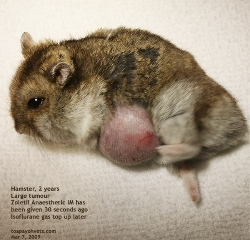 |
|
2-year-old hamster
carries a heavy load for some time and can't walk
straight. Surprisingly the skin of his wound has not been
damaged or infected.
|
It is possible that
this is a malignant tumour as it grows so big within a
short period of time. Will it recur after surgery? Hard to
tell. |
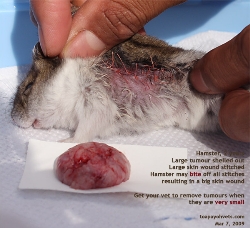 |
 |
Stitch 3-5 mm from skin incision and place sutures 5 mm
apart. The skin is not normal as it is very thin due to
stretching by this massive tumour.
Clean away all blood. Be aware of heat loss and death from
hypothermia. Therefore, do not bathe the hamster to
get rid of all the blood. This is what we will do in dogs
after similar surgery but the hamster easily gets heat
loss and dies.
TIP FOR SUCCESS: Always use general anaesthesia, esp.
isoflurane gas anaesthesia if the hamster wakes up and
struggles. Pain during surgery may cause shock and
subsequent heart failure. |
UPDATE AS AT OCT 21,
2009
My
hamster is doing fine
Hi Dr Sing,
Yeap, my hamster is doing fine. 7months plus had
passed since he had the surgery.
He's exactly 2yrs 8month old today. =)
The first week of after surgery care was terrible. I
had put him & his cage beside me through the night.
So that once he's awake, i will be waken up too to
make sure he dun do too much harm to his wound. Cos
he spent most of the daytime sleeping and gets
active at night.
Day 1 nothing happened, he sleeps and sleeps. Seems
to be running a fever. Temp is high.
Day 2, 4 out of the 6 stitches gone, remember i
brought him back to you and you said lucky u gave in
6 instead of 4 stitches.
Day 3, stitches still there.
Day 4 left with one hanging loose at the end.
Day 5, no more stitches, plus he start peeling off
the harden blood clot/skin over his wound. Guess he
peeled halfway and it starts bleeding thus he stop
peeling and left the peeled-off skin hanging there.
Day 7, He peeled everything off. New blot clot
formed. Not too big an area as compared to the
first.
Onward, I figured out that he's actually smart
enough to take good care of himself.
I fed him well and he recovered well.
BUT~
Week 2-3 , wound had healed, furs starting to grow
back. But saw another growth growing on his other
side of the body.
2 month later, the growth ballooned to half the size
of his first one. I was thinking he is quite old
already (2yrs 3 months old), I do not wish to put
him on another surgery.
I start to feed him less. I used to give him 1
tablespoon of feed everyday. Now i only give him 1
tablespoon every 3days.
With little food, he cant be picky and eats whatever
he can find in his bowl.
Another one month passed, the growth is still there.
Someday, somehow, for some reason, i realised the
furs on his chest is getting lesser and lesser.
Days passed. I did play with him everyday but didn't
really check on his growth everyday, just assumed
it's still there.
Then Someday, Somehow, for some reason, the growth
had disappeared without me knowing. I also saw
2 tiny red dot at the growth area. Seems like he bit
himself / self-treat himself.
More days passed, his fur grew back and the growth
is gone.
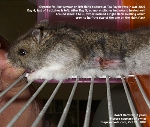 |
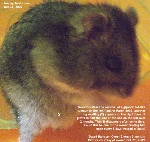 |
|
Pictures
from the hamster owner |
Another 1-2 months passed. Till date, he's still as
active, as noisy running on his wheel as always.
On and off I tune in to your website to read about
your case studies.
I count myself lucky to have him as my pet as
compared to other owners. Yeap, very lucky :)
Regards,
Name of Lady Owner |
|
 BE
KIND TO OLDER HAMSTERS --- GET TUMOURS
REMOVED EARLY --- WHEN THEY ARE SMALLER.
More case studies, goto:
Hamsters BE
KIND TO OLDER HAMSTERS --- GET TUMOURS
REMOVED EARLY --- WHEN THEY ARE SMALLER.
More case studies, goto:
Hamsters |
|
|
To make an appointment: e-mail
judy@toapayohvets.com
tel: +65 9668-6469, 6254-3326 |
 toapayohvets.com toapayohvets.com
Be Kind To Pets
Veterinary Education
Project 2010-0129
|
|
|
 Toa
Payoh Vets Toa
Payoh Vets
Clinical Research
|
|
|
Copyright ©
Asiahomes Internet
All rights reserved. Revised: August 09, 2010
Toa Payoh Vets
| |
 TOA
PAYOH VETS
TOA
PAYOH VETS









